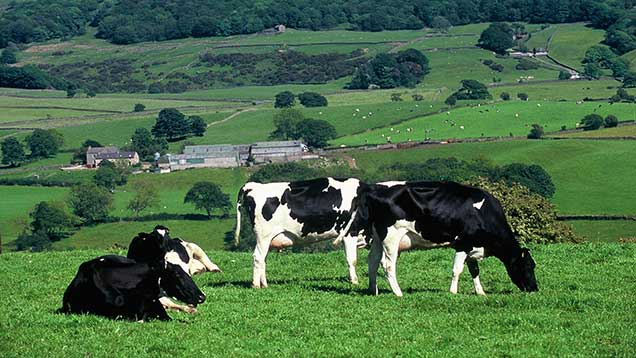Monthly must dos: Plan grazing management
 © Rex
© Rex As we head into March, we have put together some action points to look at during the month.
Dairy
Walk your grazing paddocks and check how much grass cover you have, says Piers Badnell, technical extension officer at DairyCo, as you may be surprised by how much there is and how dry it is. If there is a week’s worth of grass, you could use this for the cows or youngstock.
“Probably the most important ‘must do’ is to get cows round all the grazing by balance day in early April. So get into that wedge and don’t let the grass get away from you, as you lose quality and potential if it does.
“As a good grass manager once told me: ‘If you know where the cows are going for more than a few days, you have got too much grass’,” he adds.
The three Qs of feeding colostrum
As spring calving gets under way, it is important to consider colostrum management in terms of quantity, quality and how quickly after birth the calf receives it, according to Tom Goatman, DairyCo technical extension officer.
Colostrum is vital to a newborn calf as it contains antibodies to provide immunity and is also rich in essential nutrients providing energy for growth.
“The efficiency of antibody absorption from colostrum declines rapidly from more than 40% at birth to less than 5% by 20 hours, so it is important the calf receives colostrum ideally within two hours of birth.
“It is recommended to give a first feed (at 38°C) of three litres or 10% of body weight, followed up by another similar size feed within 12 hours of birth.
“The colostrum should be handled hygienically and be of good quality, containing at least 50g/l of antibodies. An assessment of quality can be made using a colostrometer or Brix refractometer.”
See also: More information on colostrum management
Sheep
Plan your grazing
This month grass growth will increase significantly, so now is the time to plan your grazing to maximise production from grazed grass.
The best place to start is regularly monitoring how much grass is in the field. Use a sward stick to measure the grass at various points across each field and note it down as you go. The Eblex sward stick will tell you how many kilos of dry matter is produced a hectare.
Email brp@eblex.ahdb.org.uk to get your free Eblex sward stick.
Once you’ve established how much grass you’ve got, start to plan the management and grazing.
Grass should be grazed when a third leaf has been produced on the plant. Once a fourth is growing, the first leaf will be dying and the plant puts energy into growing a seed head and not more leaves. If grass is grazed too low, future productivity of the plant is limited.
Research carried out in Ireland has found every hour spent on grassland management is worth €100 (about £70) – so a bit of planning now will pay dividends.
See also: Eblex Planning grazing strategies for Better Returns manual
Beef
Condition score your cows
Cows should be body condition scored (BCS) around calving so you’ve got time to alter condition before service.
Optimal body condition scores (2.5-3.0) are really important in achieving good levels of fertility and a 365-day calving interval.
Once scored, thin cows should be grouped with heifers and given a rising plane of nutrition. If cows have a very poor BCS they should be weaned early to allow enough time to bring them to condition before service.
See also: The Better Returns Programme on the Eblex website to download the body condition scoring leaflet
Pigs
Novel way to build staff skills
Producers are encouraged to look at different ways to help pig unit staff develop key skills, says Andrew Palmer, Bpex knowledge transfer manager.
The Bpex Practical Pig App is one simple way to help build practical knowledge.
Some stockmen don’t always feel comfortable in a classroom environment, but a number of pig producers are finding the app provides an interactive and engaging way to learn on farm with someone they know.
Managers and staff can use the app in situ out on the unit, via a smart phone, tablet or by viewing the app’s video clips on the office PC.
Download the Practical Pig App to view nearly 100 short video clips demonstrating practical on-farm tasks
Check water supply
Angela Cliff, Bpex knowledge transfer manager, says water quality and availability are both key to pig performance but are often overlooked.
Pig producers should ensure they look at water supply as well as analysing feed when investigating any performance problems.
Producers should aim to check all drinkers are clean and working on a daily basis and check flow rates of every nipple and bite drinker regularly.
The complete water line, including drinkers, pipe work and header tanks, should also be regularly cleaned and flushed through.
Health
James Aitken, Nadis vet expert, says routine jobs for March should include vaccinating at-risk cattle for leptospirosis and worming lambing ewes.
Leptospirosis can cause milk drop, infertility and abortion. Cattle are most at risk during the spring and summer months at pasture, especially if they have access to shared water supplies such as streams and ditches.
Lambing ewes should also be wormed to prevent pasture contamination where appropriate, paying particular attention to Scops (Sustainable Control of Parasites in Sheep) principles to help prevent drug resistance developing.
